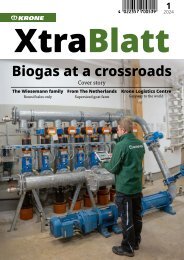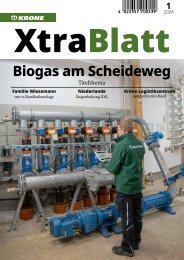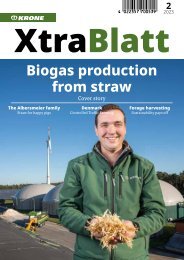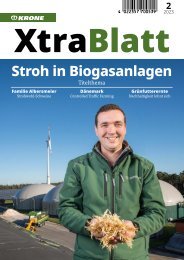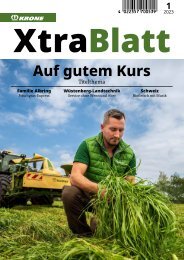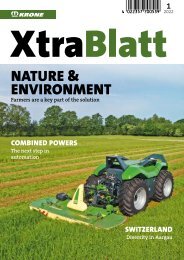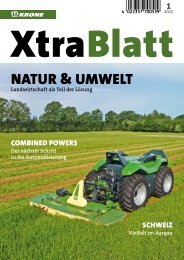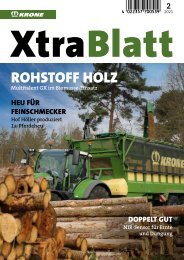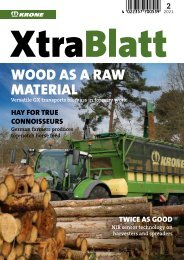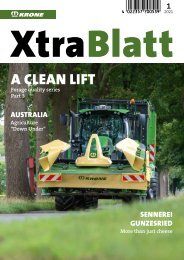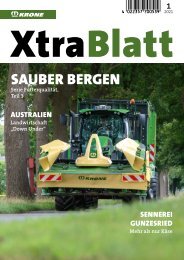XtraBlatt Issue 01-2023
Create successful ePaper yourself
Turn your PDF publications into a flip-book with our unique Google optimized e-Paper software.
Optimal forage quality<br />
“One of the keys to optimal forage quality is the<br />
chop length,” says Harry Wesch. And this should<br />
be short, because short chops causes pH to drop<br />
more rapidly during the ensiling process, thereby<br />
minimising the risk of butyric acid fermentation.<br />
Furthermore, a shorter chop length creates a<br />
greater surface area, which in turn enables cows<br />
to digest the feed more easily, absorb more energy<br />
and thus more milk.<br />
The system is particularly popular with<br />
customers who often harvest sandy or<br />
stony land.<br />
Harry Wesch, contractor<br />
In brief<br />
Fact 1<br />
Abound one third of all<br />
Krone forage wagons<br />
have the SpeedSharp<br />
blade grinder.<br />
Fact 2<br />
The economic benefits<br />
of the grinding system<br />
include a noticeably<br />
better fuel economy in<br />
the field and significant<br />
time savings during<br />
sharpening.<br />
Fact 3<br />
Chop length and<br />
quality are among the<br />
key factors for optimal<br />
forage quality. Shortchop<br />
forage leads to a<br />
more rapid reduction in<br />
pH, thereby minimising<br />
the risk of butyric acid<br />
fermentation.<br />
1 The blade grinder is<br />
lifted into position. A few<br />
simple operations, then<br />
grinding can begin.<br />
2 Ready to go again.<br />
Dennis Jenk shows a<br />
cutting edge that<br />
has just been sharpened<br />
while on the machine.<br />
3 The discs produce<br />
a consistent grinding pattern,<br />
thanks to springs<br />
ensuring a uniform<br />
contact pressure.<br />
“In addition, farmers and contractors who seek<br />
to produce optimal quality forage require consistently<br />
sharp blades and therefore appreciate<br />
the fact that our SpeedSharp system can sharpen<br />
those 48 blades on our forage wagons in a matter<br />
of minutes!”<br />
A sandy challenge<br />
Having consistently sharp blades is a particular<br />
challenge for contractors who harvest on varying<br />
soils. “The sandy, often stony soils in the local<br />
Geest region soon take it out of the blades. And<br />
if the customer prefers a very short cut, you just<br />
have to accept that the blades will need re-grinding<br />
after only a few trips to the clamp,” explains Harry<br />
Wesch. The blades were not always able to cope<br />
with these stresses, he went on to explain. “In the<br />
first few years we often had to deal with broken<br />
or torn blades,” says the contractor. A problem<br />
that Krone has now solved with the introduction<br />
of the more resistant HD blades, says Benedikt<br />
Lambrecht-Speller. Harry Wesch values this level<br />
3<br />
1 2<br />
of customer focus: “You call them, explain the<br />
problem – and a few weeks later Emsland comes<br />
up with a solution.” It’s not something the contractor<br />
takes for granted, but ultimately this level<br />
of service is behind his decision to rely almost<br />
entirely on Krone for the forage harvesting side<br />
of his business.<br />
Although today, the cut grass is also often picked<br />
up by foragers, forage wagons do present a more<br />
cost-effective option in many situations. “This<br />
is especially true when the fields are small or remote,”<br />
explains Christoph Jenk, who is responsible<br />
for the workshop and scheduling. Apart from that,<br />
some farmers don’t like to see the heavy foragers<br />
go into their boggy grasslands that are so abundant<br />
in the region. Therefore, during the grass season<br />
the contractor’s three forage wagons are usually<br />
kitted out with their own pick-ups. “Of course, we<br />
also run the forage wagons alongside the forage<br />
harvester, depending on the harvesting chain,”<br />
says Dennis Jenk.<br />
For delivering their customers forage of a consistently<br />
premium quality, the contractor must<br />
use sharp blades in the first place. Therefore, the<br />
company makes a particular point of diligently<br />
sharpening the blades at the end of each harvest<br />
day. Most blades are resharpened in a stationary<br />
grinding machine at their workshop. But at peak<br />
times there’s often a backlog of blades waiting to be<br />
re-sharpened during the evening. The SpeedSharp<br />
blade grinder has gone a long way towards alleviating<br />
this situation. However, the forage wagon<br />
blades still need re-sharpening on the stationary<br />
machine at regular intervals.<br />
The Harry Wesch contracting business began<br />
operating from a farm in 1991 and now employs<br />
eight full-time and twelve temporary staff. Forage<br />
harvesting is the mainstay of their business, and<br />
for this, the company uses mainly Krone machinery.<br />
The cutting is done with two butterfly mower<br />
combinations. Raking and grass collection is done<br />
with Krone equipment. The machine fleet includes<br />
three forage harvesters – two BiG X 850 and one<br />
BiG X 1080 –, two Krone rakes and the three ZX<br />
series forage wagons already mentioned.<br />
Less diesel consumption<br />
Colleague Torben Trzeciek has just resharpened<br />
the blades on his forage wagon combination. Like<br />
all drivers of forage wagons, he knows exactly how<br />
to operate the blade sharpener and uses it a dozen<br />
times per year during forage harvesting, which<br />
can involve up to five cuts. In his view, abrasive<br />
consumption is comparatively low. “We replace<br />
the abrasive flap discs that have reached their wear<br />
limit at the end of the season,” explains Torben<br />
Trzeciek. But he doesn’t just use the SpeedSharp<br />
when the blades are noticeably blunt. He also<br />
grinds the blades before heading off to a new customer.<br />
“New customers tend to inspect the first few<br />
loads particularly carefully. So obviously it’s a good<br />
thing if the first wagon load has been processed<br />
with freshly sharpened blades,” he explains, ever<br />
the grassland professional.<br />
Regular resharpening also makes sense in terms<br />
of operating costs. “Significantly less tractor power<br />
is needed for cutting when you have freshly<br />
sharpened blades,” explains Christoph Jenk. This<br />
is reflected in a reduced fuel consumption, which<br />
the Wesch repair shop manager puts at around 1 to<br />
2%. But it’s the same story with any machine with<br />
blades. Sharp blades cut through the forage with<br />
ease. As the blades become dull during the course<br />
of the day, there is a noticeable increase in fuel<br />
consumption. So for contractor Harry Wesch, the<br />
SpeedSharp blade grinding system is a win-win.<br />
The customer benefits from optimum chop quality,<br />
the contractor from reduced fuel consumption and<br />
there is less risk of customers complaining about<br />
the silage quality. «<br />
A highly motivated<br />
team – Harry Wesch<br />
and his team provide<br />
local farmers with an<br />
efficient and reliable<br />
service that covers<br />
more than<br />
forage harvesting.<br />
42 1|<strong>2023</strong> <strong>XtraBlatt</strong><br />
<strong>XtraBlatt</strong> 1|<strong>2023</strong><br />
43



